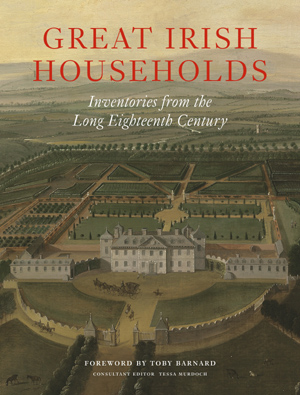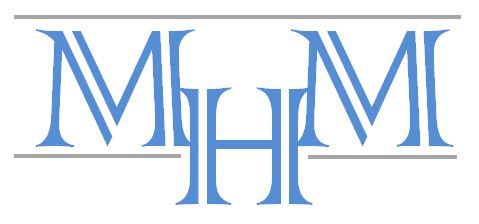The value of inventories in charting how houses were arranged, furnished and used is now widely appreciated.
Typically, the listings and valuations were occasioned by the death of an owner and the consequent need to deal with
testamentary dispositions. That was not always so. The inventory for Castlecomer House, Co. Kilkenny, for example, was
drawn up to make a claim following the house’s devastation in the 1798 uprising.
Mostly hitherto unpublished, the inventories chosen give new-found insights into the lifestyle and taste of some of the
foremost families of the day. Above stairs, the inventories show the evolving collecting habits and tastes of
eighteenth-century patrons across Ireland and how the interiors of great town and country houses were arranged or
responded to new materials and new ideas. The meticulous recording of the contents of the kitchen and scullery likewise
sheds light on life below stairs. Itemized equipment required for the brewhouse, dairy, stables, garden and farmyard
reflects the at times significant scale of the communities the houses supported and the remarkable degree of self-sufficiency
at some of the demesnes.
A comprehensive index facilitates access to the myriad items within the inventories, while the books listed at three of the houses
are tentatively identified in separate appendices. A foreword, together with preambles to the inventories, sets the households in their
historical context.
Illustrated with historical engravings of the houses and with portraits of the owners of the time, the inventories
will appeal to country-house visitors, historians of interiors, patronage, collecting and material culture as well as to scholars,
curators, collectors, creative designers, film directors, bibliographers, lexicographers and historical novelists.
The eighteenth century is the period onto which the Knight of Glin directed his penetrating gaze as art historian. The book
is dedicated to his memory.
‘[This book] succeeds admirably in its aims and will be the go-to sourcebook on material culture in the great Irish house, above and below stairs, for many years to come.’
William Derham, European Journal of Food, Drink and Society, December 2024
‘The past may be irrecoverable, but such documents [as these inventories] make it feel almost tangibly close. . . .
The exceptionally full index makes it possible to trace the use of particular types of furniture or material across the course
of the century. . . .’
Michael Hall, Times Literary Supplement, 4 August 2023
‘There is so much information that recitation here would be exhausting, but for sheer extravagance, exuberance and breath-catching detail, the domestic and service sections of the Carton House inventory from 1818 take some beating . . ."’
Tom Jaine, Petits Propos Culinaires, 125, April 2023
‘[T]his collection is a cornucopia of information, and while its primary audience will be scholars and curators, there is plenty to be
gleaned from the listings for anyone interested in historic interiors’.
Christopher Ridgway, Journal of the History of Collections, March 2023
‘A box of geeky delights, certainly, but also a fabulous (one might even say indispensable) source for the scholarly study of the
Irish country house . . .’ Adrian Tinniswood, The Critic, February 2023
‘The lists of books . . . are a valuable addition to a developing body of scholarship on printing, publishing, bookbinding and reading in
Ireland before 1800.’ Marie Boran, Eighteenth-Century Ireland, vol. 38, 2023
‘All in all this is a model production which will be of permanent use to students of Irish houses, and indeed of those throughout Great
Britain.’ Simon Swynfen Jervis, Furniture History Society Newsletter 230, May 2023
‘This is a beautiful production – elegantly laid out, printed and bound into a neat volume, with a fine dust jacket . . .
It covers a fascinating subject, which brings us back in time and throws much light on how people lived.’ Peter Pearson, Irish Arts Review, Spring 2023
‘[The book] will be an invaluable and rich source of information for scholars and I know I will be using it on a regular basis.’
James Rothwell, National Curator, Decorative Arts, National Trust
‘Historic household inventories recording the contents of rooms are an essential documentary tool for understanding the use and
appearance of houses in the distant past. For anyone with a serious interest in Irish Georgian houses, this collection of 18 transcribed inventories,
each prefaced with a short introduction on the house in question, is an essential work of reference.’
Country Life
‘[A]cross the span of some 120 years and the [inventories published in the book] it is possible to see how the decoration and design of affluent
Irish households changed.’
Robert O’Byrne, Apollo Magazine, February 2023
‘It’s not hard to see how a set designer on a film set in a grand 18th-century house would pore over the details in the book
to find out how many paintings to put in the hall, whether there should be a rug on the floor and might it really be made of velvet . . .’
Irish Times
top
|
ACKNOWLEDGEMENTS by Tessa Murdoch
PREFACE by Leslie Fitzpatrick
MAP OF IRELAND
FOREWORD by Toby Barnard
THE INVENTORIES
1
2
3
4
5
6
7
8
9
10
11
12
13
14
15
16
17
18
|
Lismore Castle, Co. Waterford, 1702/3
THE ORMONDE INVENTORIES
Kilkenny Castle, Co. Kilkenny,1705
Dublin Castle, 1707
The Duke of Ormonde’s House, London, c. 1710
Bishop’s mansion house, Elphin, Co. Roscommon, 1740
Captain Balfour’s town house, auction sale, Dublin, 1741/2
Hillsborough Castle, Co. Down, 1746 and 1777
Kilrush House, Freshford, Co. Kilkenny, 1750
No. 10 Henrietta Street, Dublin (Luke Gardiner’s house), 1772
Morristown Lattin, Co. Kildare, 1773
Baronscourt, Co. Tyrone, 1782
Castlecomer House, Co. Kilkenny, 1798
Killadoon, Co. Kildare, 1807–29
Shelton Abbey, near Arklow, Co. Wicklow, 1816
Borris House, Co. Carlow, 1818
Carton House, Co. Kildare, 1818
Newbridge House, Co. Dublin, 1821
Mount Stewart, Co. Down, 1821
|
Glossary
APPENDIX I: Buyers at Captain Balfour’s town house sale, 1741/2
APPENDIX II: Books in the second Duchess of Ormonde’s closet at Kilkenny Castle, 1705
APPENDIX III: Books in the study at the bishop’s mansion house, Elphin, Co. Roscommon, 1740
APPENDIX IV: Books in the library at Newbridge House, Co. Dublin, 1821
List of inventory sources
List of plates
Bibliography
Index of personal names
General index
|
top
|
Toby Barnard, FBA, is emeritus fellow in history at Hertford College,
University of Oxford. A specialist in the political, social and cultural histories of Ireland and England,
c. 1600–1800, his books include: Making the Grand Figure: Lives and Possessions in Ireland, 1641–1770 (2004);
and
Guide to the Sources for the History of Material Culture in Ireland (2005).
Tessa Murdoch, FSA, is an independent scholar. After forty years as curator at the Victoria and Albert
Museum and Museum of London she is working with the British Museum on a programme for Britain and Ireland to mark the bicentenary of Catholic
Emancipation in 2029. Her work on Huguenot refugee art and culture,
Europe Divided: Huguenot Refugee Art and Culture, was published in 2021.
Her engagement with inventories was inspired by researching the archives of the dukes of Montagu for Boughton House: The English Versailles
(1992); and under her editorship Noble Households: Eighteenth-Century Inventories
of Great English Houses was published in 2006.
Jessica Cunningham is a design historian and archivist. Completing her doctorate at Maynooth University in 2016,
her research has been published in Irish Architectural and Decorative Studies; in History of Retailing and Consumption; and in
Silver Studies.
Rebecca Campion, a graduate of the University of Cambridge,
completed a doctorate at Maynooth University in 2012. She is a teacher, occasional lecturer and independent
scholar with particular interest in material culture, collecting, display and the Grand Tour.
Alec Cobbe was educated in Ireland and at Corpus Christi College, University of Oxford.
He trained as a paintings conservator at the Tate Gallery and has practised as an artist and designer of historic interiors.
His design career archive now forms a part of the collections of the Victoria and Albert Museum. He divides his time between Newbridge House,
Co. Dublin, where he grew up, and Hatchlands Park, Surrey, where the collection of composers’ keyboard instruments which he
formed over fifty years is on display. His publications include James Gibbs in Ireland (2005) (with Terry Friedman) and Chopin’s Swansong
(2010). His latest book, Birds, Bugs and Butterflies: Lady Betty
Cobbe’s ‘Peacock’ China, was published in 2019.
Edmund Joyce is a lecturer at South East Technological University, Carlow.
Since completing his MA in Historic House Studies at NUI Maynooth, he has published extensively on a
wide range of topics relating to material culture and architectural history. His MA thesis,
Borris House, Co. Carlow,
and Elite Regency Patronage, was published by Four Courts Press in 2013 as part of the Maynooth Studies in
Local History Series.
Leslie Fitzpatrick was the Samuel and M. Patricia Grober Associate Curator,
European Decorative Arts, The Art Institute of Chicago. She was one of the curators of the exhibition Ireland:
Crossroads of Art and Design, 1690–1840 held at the Art Institute in 2015.
John Adamson, FSA, is a graduate of the University of Edinburgh.
After working for Cambridge University Press and the National Portrait Gallery, London, he set up a small
publishing house and has been publishing books in the decorative arts for more than twenty years. |
|
Philip Lewis designed the book, setting the body in Rosart. He chose this handsome serif face that was designed and adapted for the digital
age by Katharina Köhler of Camelot Typefaces in Leipzig. Based on a type specimen by the Namur-born typefounder Jacques-François Rosart,
published in 1768, it is modern in feel, highly readable, yet retains an eighteenth-century elegance.
Martin Lubikowski drew the maps on p. 10, broadly basing his map of Ireland on John Rocque’s map (1794 edition).
Opero in Verona, Italy, printed the book on Munken Lynx 120 gsm and the colour-plate sections on GardaPat 13 Bianka 135 gsm.
|
top
|
Contact the
publishers or local agents for further information: Enquiries
|
top
|
Please print off the order form and
send it by mail to John Adamson, 90 Hertford Street, Cambridge CB4 3AQ, England.
|
top
|


